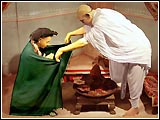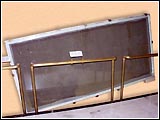
|
 |
 |
 |
 |
Hall
of Garments
|
 |
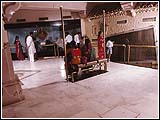 |
The
interior is pious and precious. Textiles used by Bhagwan Swaminarayan have
been treated, restored and displayed artistically and scientifically.
The garments the Lord wore in the region of Kutch, have been glass-framed
on a wall with Kutch designs. A traditional roof-tiled entrance invites
you into 18th century Chhapiya. Enlighten yourself on the traditional garments worn by Bhagwan Swaminarayan: Pagh | Jamo | Surwal | Doriyani Khes | Moka khachar's khes | Jariyani Khes | Miraculous Khes | shawl | Coarse Shawl | Gal Masuriyu | Dhoti| Topi of kutch | Gaumukhi | Angarkhu | |
||
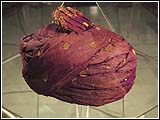 |
Pagh: A Pagh is a finely woven, very light cloth traditionally tied round the head as a head-dress. Normally, Bhagwan Swaminarayan wore a white Pagh on His head. But during festivals, He sometimes wore colorful and ornate clothes, like this Pagh of purple silk embroidered in gold. It was given by the Lord to Ram Raja and then kept in the mandir at Muli. Acharya Devendraprasadji Maharaj, In 1953, Yogiji Maharaj had helped in the creation of Chhapiya railway station. Out of gratitude, Acharya Devendraprasadji offered this, Bhagwan Swaminarayan's Pagh to Shri Chhaganbhai Patel, a devotee of Yogiji Maharaj gave it to Chhaganbhai Patel, whose grandson, Pranav Kiritbhai Patel, donated it to Pramukh Swami Maharaj in 1992. |
||
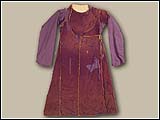 |
Jamo: Jamo is an upper garment worn like a long coat. It has no collar, full sleeves and is tied with strings instead of buttons. Although, Bhagwan Swaminarayan preferred white clothing, the devotees offered rich and ornate clothes during celebrations. To satisfy their love, He accepted and sanctified their gifts by wearing them for the occasion. This beautiful Jamo of purple velvet and gold lining was casually kept in wooden boxes for generations, until it was scientifically treated for conservation and put on display at Akshardham. |
||
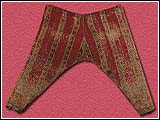 |
Surwal: The Surwal is a traditional trouser-like garment worn from the hips down to the ankles. However, this is a special kind, the Godadiyo Surwal. It is padded with cotton wool to provide extra comfort and protection from cold. The Kathis wore such thick, warm clothing during winter. In practice, it is tied around the waist with a waist cord to get a perfect fit. This red patterned Surwal belonged to the Lord Himself and has been duly preserved. |
||
Doriyani Khes: Khes is the upper garment. Doriyani Khes, often worn by Bhagwan Swaminarayan was handwoven in the typical Doriya texture. |
|||
Moka Khachar's Khes: Once Bhagwan Swaminarayan was traveling to Vankiya. Moka Khachar went to receive the Lord but discovered that the river was flooded. He risked his life and carried the Lord on his shoulder into the town of Vankiya. Pleased with him, the Lord gave this Khes - upper garment to Moka Khachar. |
|||
Jariyani Khes: Once while walking to the village of Vadtal, the Lord was pleased with Pitambar Lavji Thakkar of Budhej and as a sign of grace, gave him His Jariyani Khes which was beautifully handwoven with golden threads. |
|||
Miraculous Khes: The couple Jagrup Barot and Sajuba of Sinjiwada were childless. In 1816 CE, shortly after Bhagwan Swaminarayan blessed their house, they got a son. Unfortunately, his arms and legs were short and gravely deformed. On His next visit, the Lord placed the child in His lap, gently covered him with His Khes. Instantly, the child became normal and beautiful. That very Khes is carefully exhibited in this Hall of Garments. |
|||
Shawl: One of the most important holy articles, this shawl was placed round the shoulders of Neelkanth Varni (Bhagwan Swaminarayan) when He was appointed the head of the fellowship by Ramanand Swami. Bhagwan Swaminarayan was just 20 years old when Ramanand Swami arranged a grand celebration in the village of Jetpur to appoint Him as the head of the Fellowship. On 16 November 1801 CE, during the ceremony, he placed this woollen shawl round the young Lord's shoulders. |
|||
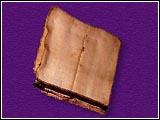 |
Coarse Shawl: A poor devotee gave Bhagwan Swaminarayan a very coarse, prickly shawl. Despite the discomfort and His skin being grazed, the Lord refused to part with the shawl. Then Gunatitanand Swami, His favorite sadhu, reasoned that he felt cold and needed a shawl. The Lord gave it to him saying, "He is my Jadbharat" meaning that Gunatitanand Swami cares little for the comforts of his own body. A piece of that historic shawl is on display. |
||
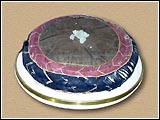 |
Gal Masuriyu: Padded with cotton wool, this small round pillow-like 'Gal Masuriyu' was placed under His chin and cheek by the Lord when He retired for rest. |
||
Dhoti: The dhoti is a fine textured cloth worn around the waist as a garment for the lower part of the body. The cotton dhoti of Bhagwan Swaminarayan preserved in Akshardham was passed on by the descendants of Mayaram Bhatt. |
|||
Topi of Kutch: Topi means a cap. The yellow cap displayed in Akshardham was worn by Bhagwan Swaminarayan before and during the disastrous famine of 1869 VS. He forewarned people by asking them to save grains, and reached out to them with food and other relief help. |
|||
Gaumukhi: Gaumukhi is a cloth bag worn round the hand while turning the mala. During the yagna at Dabhan on Posh sud 15, 1866 VS Bhagwan Swaminarayan chanted the holy mantra along with thousands of brahmins. The very Gaumukhi in which the Lord counted His malas, is on display in Akshardham. |
|||
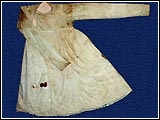 |
|
|
|
|
© 1999, Bochasanwasi
Shree Akshar Purushottam Swaminarayan Sanstha, Swaminarayan Aksharpith
|
